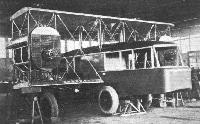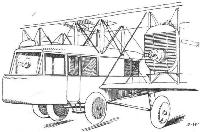
Flight, March 1920
THE GRAHAME-WHITE E-8 NINE-SEATER LIMOUSINE
SINCE the description of the Grahame-White four-seater limousine appeared in FLIGHT for September n , 1919, another model has been designed, and is now practically "ready for the air." Except for certain modifications in the fuselage necessitated by the extra seating accommodation provided, and in one or two detail improvements resulting from practical experience with the four-seater, this new model – the E-8 - is identical in general design and construction to the first machine. We do not, therefore, propose giving a full description of the new nine-seater, but will confine our remarks to the general characteristics of the machine and the new features, which, together with the accompanying scale drawings, should suffice to give all the essential information.
The E-8, we understand from the Grahame-White Co., is primarily a luxury machine, and not a low-priced commercial one - that is, it is comparable to the costly touring car or yacht, the best material and workmanship obtaining throughout, and finish not being sacrificed to other considerations. Whether the time is ripe for such a machine remains to be seen; one thing is certain, however, such an aeroplane will be wanted sooner or later, and the Grahame-White Co. are determined to be ready.
As previously stated, the main alterations in the E-8 are to be found in the fuselage. As before, it is built-up in two main sections, that aft of the main planes being of wire-braced girder construction with square section longerons and channel section struts. From the main planes forward the fuselage - the "business portion" - is built-up on hoop formers of ash reinforced with three-ply covering. The rounded nose is now of sheet metal, which enables a much neater job to be made of this part than when it was of three-ply. The main passengers' cabin projects forward of the main planes, and is now 2 ft. 6 ins. longer on account of the extra accommodation. The interior finish and furnishing are as before, likewise the arrangement of the large Triplex windows. The middle portion of the cabin, at the main planes, is reserved for the fuel tanks. At the extreme rear of the cabin is a small compartment which can be used either for luggage or for two passengers. This cabin has two windows each side, and a door on the port side.
The pilot, in the E-8, is located further back, the cockpit being immediately behind the cabin and the main planes, instead of, as before, underneath the top plane. The "conning tower" arrangement has been dispensed with, and an ordinary small wind-screen provided instead. Whilst the fore portion of the fuselage has been lengthened, the rear portion, from the trailing edge of the main planes rearward, has been shortened by 1 ft.; the overall length is, nevertheless, 1 ft. 6 ins. longer.
There is no material difference in the main planes, the overall dimensions being as before. The tail plane is a little shorter in span, and has undergone slight modifications in the angle of incidence adjustment gear. The leading edge is now fixed, and the rear spar is raised or lowered. The fin area has been reduced by 2 sq. ft. or so, but otherwise the tail surfaces remain much the same.
Except that it is slightly more springy, the landing chassis is similar to the previous one, the results obtained from the first model having been highly satisfactory.
The power plant is also similar, consisting of two 320 h.p. Rolls-Royce Eagle V engines, driving tractor screws.
As before, the principal feature of the control is in the novel arrangement of the rudder-bar, which is mounted below the floor with its pedals projecting through, and sliding in slots in, the floor-boards. The engine-controls are mounted on the right-hand side of the pilot's cockpit. An interconnected throttle-lever is fitted, which opens and closes both throttles in unison or independently.
- Flight, March 1920
THE GRAHAME-WHITE E-8 NINE-SEATER LIMOUSINE
Фотографии
-
Air Pictorial 1955-12 / Photos by request
GRAHAME·WHITE AERO-LIMOUSINE. This little-known aeroplane was one of the first attempts at building an airliner, and appeared in September 1919. It was designed by M. Boudot, and was one of the last types to be produced by the Grahame-White Aviation Co. Ltd. at Hendon before going into liquidation. Only the prototype was built.
The Aero-Limousine seated four or six passengers in a cabin in the extreme nose, and the pilot occupied a raised "conning-tower" immediately behind. Two 320-h.p. Rolls-Royce Eagle V watercooled engines drove four-blade wooden airscrews 10ft. in diameter. Span. 60ft.; length, 39 ft.; weight loaded, 7,947 lb.; maximum speed, 116 m.p.h. -
Flight 1920-03 / Flight
The Grahame-White E-8 nine-seater Limousine. A view of the centre portion, showing the Rolls-Royce engines, cabin, landing-chassis, etc.
-
Flight 1920-03 / Flight
A sketch showing the general arrangement of the cabins of the Grahame-White limousine
-
Flight 1920-03 / Flight
The adjustable shutter on the radiator of the Grahame-White limousine
-
Flight 1920-03 / Flight
A sketch of the tail-skid on the Grahame-White limousine
-
Flight 1920-03 / Flight
THE GRAHAME-WHITE E-8 NINE-SEATER LIMOUSINE: Plan, side and front elevations to scale
- Фотографии





